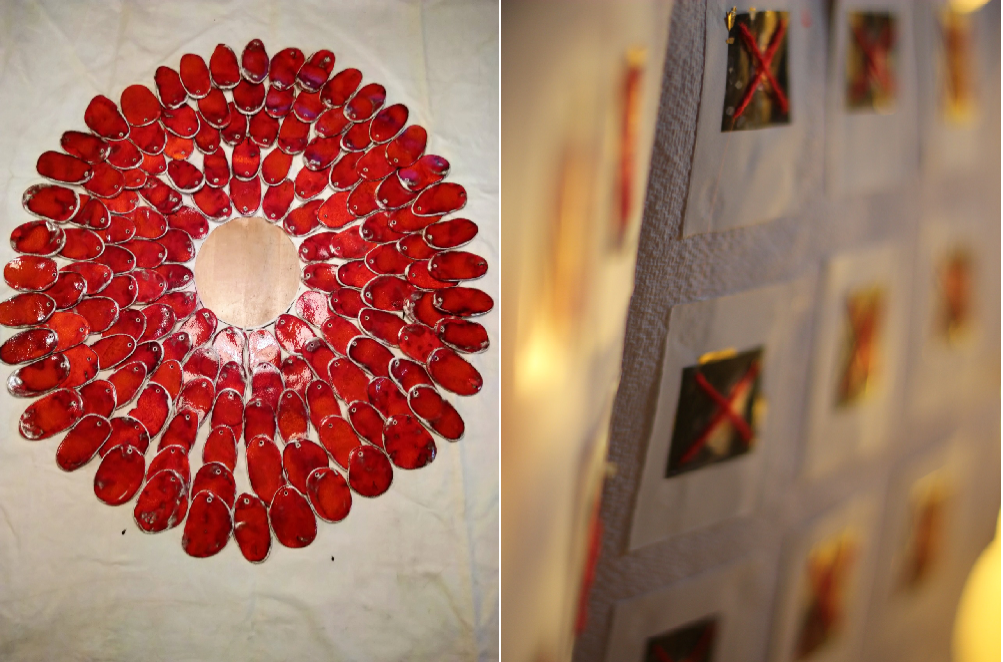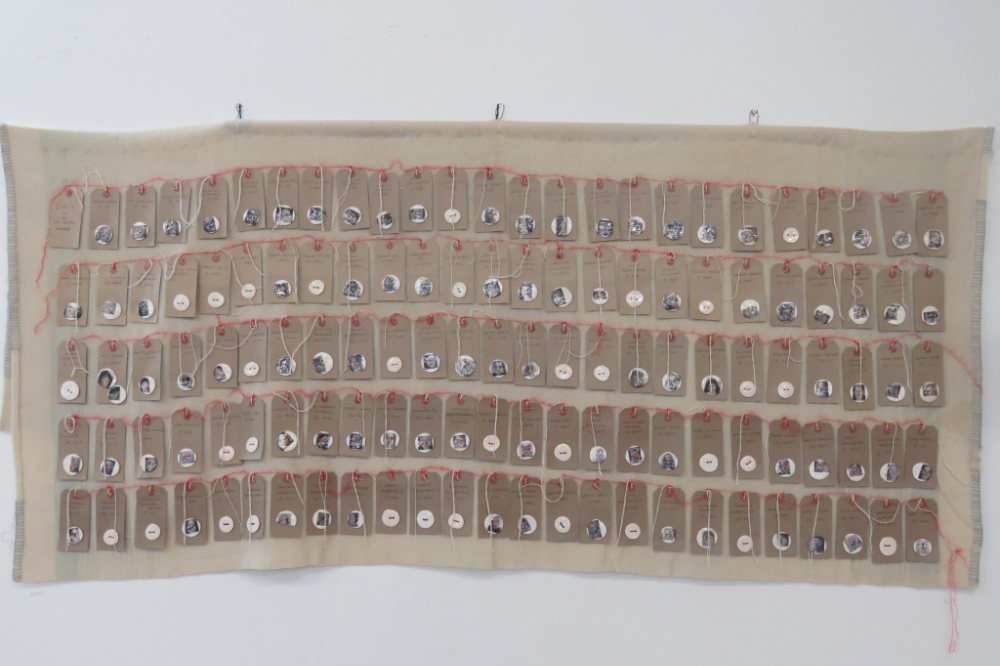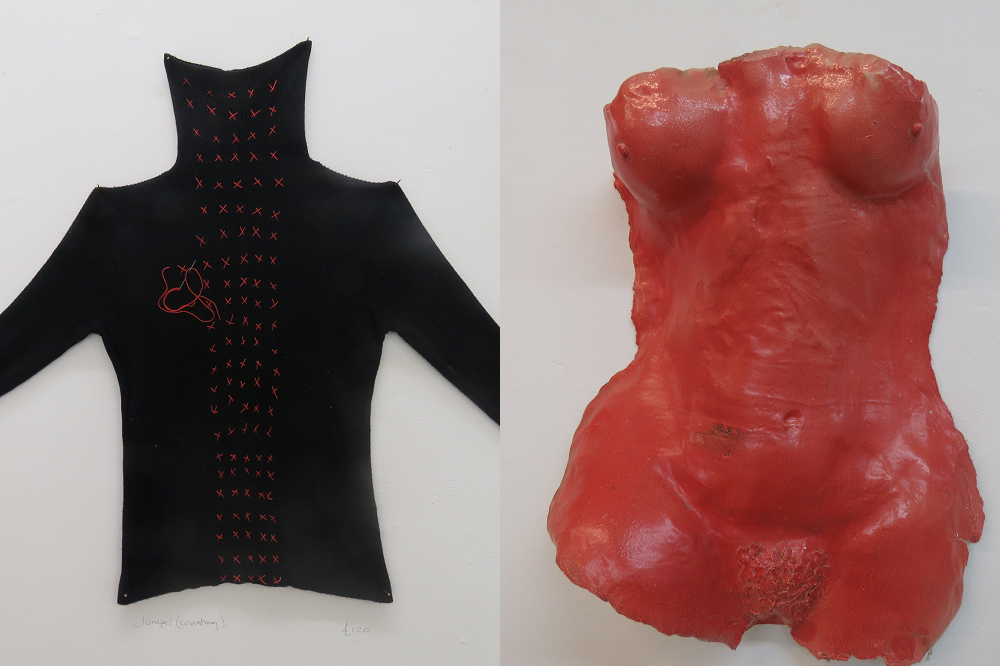Exhibition: Counting dead women is a fine art – ‘Manslaughter’ by dinahvagina

Sarah Morgan Jones
‘Manslaughter’ is an exhibition of work about domestic violence and the murder of women, by Carmarthenshire based artist dinahvagina, presented to mark ‘International Day for the Elimination of Violence Against Women’ on 25 November.
Since the days of the swing-o-meter, we have become well used to infographics, and as technology has developed and the fine art of spin came into legitimate use, we also know that statistics can be made to say whatever people want them to say, in any format that suits.
When we see graphs and pie charts and fancy 3D app-based stats modelling, or figures per hundred thousand or percentage or per hundred grams, we can often be forgiven for thinking Bullshit Baffles Brains
When it comes to counting women who have been murdered by men, the figure we most often hear is three women a week, every week. For years.
And that’s just in the UK. Three women a week. So, Monday, Wednesday, Friday every week, say, a woman is murdered by a man. Who counts these women?
The ONS counts, but it doesn’t hold data on the sex of the victim by the sex of the suspect. It does however show that more men are killed either by their children, their friends, or a stranger than by an ex/partner. It also shows that more women are killed by their ex/partner than by any other person.
Karen Ingala Smith counts, first recording the data in her Counting Dead Women blog and then with Clarissa O’Callaghan, developing that into the Femicide Census in 2015.
Jess Phillips MP reads from this list in parliament every year on International Women’s Day, meaning Hansard has to count.
And Carmarthenshire artist dinahvagina counts. She counts them and she honours each and every woman’s life taken by a man, by incorporating the woman into an infographic work of art. ‘Manslaughter’ is her latest exhibition of this beautiful, powerful and thought provoking project.
Weapons of choice
When I met Dinah at the gallery at Volcano Theatre on High Street, Swansea, I was not sure what to expect. Accompanied by Ali Morris, who has been working in the domestic and sexual violence sector for ever and a day, I definitely feel like the novice in the room.
At first glance I see a trench coat on a tailor’s mannequin with passport sized photographs stitched on to it with a red silk X.
I see rows of parcel tags tied to a wall hanging, with a handmade ceramic button on each tag, holding a passport sized photo in place. That represented the women who were killed in 2015.

I see many more tags, adorned with faint neat writing, hanging from a tablecloth on an occasional table, the legs of which have been replaced with huge chef’s knife, a hammer, a cricket bat and a lawn edging spade. That represented the women killed in 2018 and the legs symbolised some popular weapons of choice for that year.
And I see a full-sized staircase made of soft white fabric, stuffed full like a mattress, but sewn into treads, and decorated with what I later discover to be appliqued love letters.
The staircase was a response to a photograph of the scene that met police officers when they attended a domestic violence incident. On every one of the bare wooden treads a knife stood point down, fixed in each side, as if thrown by a skilled knife thrower.
They had been. He had thrown them there to terrify and threaten his partner. The police said a life was saved.
“You can lie on that if you want. It’s very comfortable. All my work is to there to be touched and handled, I encourage it, in fact. It’s tangible, tactile.”
Indeed, everything I saw made me want to touch it. Each work radiated tactility, and homeliness and beauty, and made me want to put my face close enough to perhaps inhale.
This had a soothing effect, calming my nerves, slowing my movements, and although I was increasingly saddened or shocked by each name or representation, I also felt I was seeing each of them.
I was moving away from the ‘three women a week’ mindset to a ‘hello, you and you and you’ one.

“men kill themselves and each other more than they do women, but the intersection of male violence and women is brutal”
Data gathering is a constant background activity for Dinah, she’s always tuned into it, although she makes the pieces in one go.
I wonder how it makes her feel, with this kind of information in her consciousness constantly. She has after all been creating these pieces for the best part of a decade.
“I seem to have a vaguely professional detachment and I intersperse work about violence with work relating to female sexual agency.”
In an online profile she says she “wants to change the way the world perceives women, and the way women perceive themselves, to encourage female agency and refute objectification.”
In these representations, we see ‘woman,’ but we do not see her in isolation. We see her and what was done to her and who did it to her. We see that her place in the world was ended because of the who and the what.
Dinah tells me: “It’s about language… If we talk about a woman who was battered… It’s all about her and the perp has disappeared.
“If you say Bruce beat Jane then you have the active party, the act and the victim. If you isolate her and only speak of her, she starts to be seen as responsible for everything that befalls her.”

“Lobster: you would not choose to dive into the boiling water, but you can find yourself in it. Things may turn from good to bad by a thousand tiny steps”
Away from the main exhibition (of which there is far more than I can describe here), there is a dimly lit room on the door of which there is a warning to approach with the understanding that we cannot un-know things once we know them.
Inside that room are two mighty tomes, one called Album, which contains over 1000 small portraits representing women murdered by men in the UK between 2012 and 2019. The other is called Brutal and it explores the data behind the images.
Each book is big and heavy and textured and wrapped in beautiful fabric.
These books are not graphic or gory, they do not objectify or glorify, but they are devastating, and in the company of Dinah and Ali, I felt safe and connected in the face of what I could not now ‘un-know’.
The exhibition is called Manslaughter and is in place to mark International Day for the Elimination of Violence Against Women and the White Ribbon campaign which is on 25 November and extends for a further 16 days. It is a campaign to end male violence against women once and for all.
This year’s message is #AllMenCan emphasising, in the wake of the murder of Sarah Everard – when women’s experience of male violence became part of the mainstream conversation, prompting governmental policy reviews and debate – how men can take action and make a stand, and make the ‘White Ribbon Promise’ never to commit, excuse or remain silent about male violence against women.
The exhibition runs until 3 December at Volcano Theatre, High St Swansea.
Details of White Ribbon Campaign which marks International Day for the Elimination of Violence Against Women can be found here
Support our Nation today
For the price of a cup of coffee a month you can help us create an independent, not-for-profit, national news service for the people of Wales, by the people of Wales.






Excellent,worth a visit
An incredible piece of work by Dinah which highlights the murder of so many women in this country. It is done with such sensitivity and focus on the real issue of male violence against women.